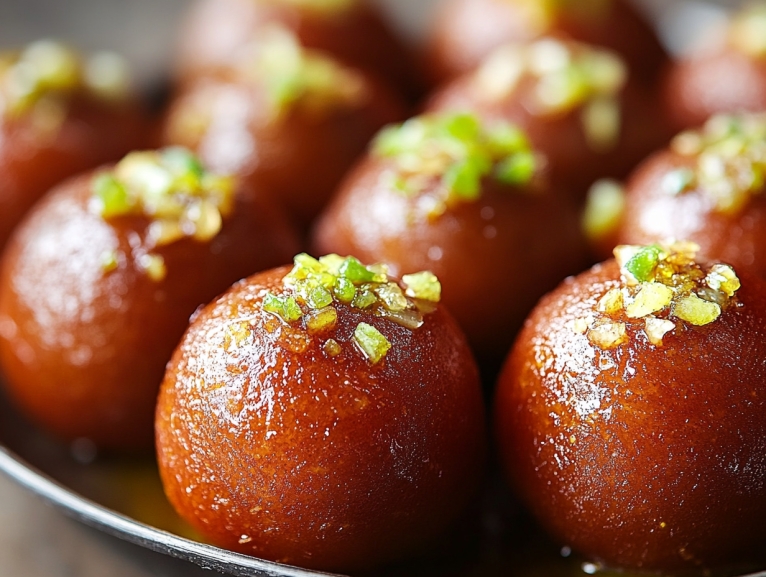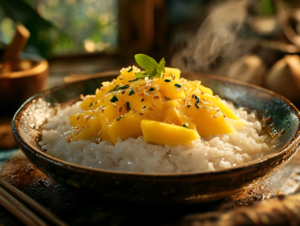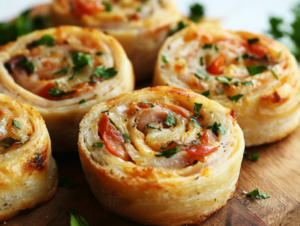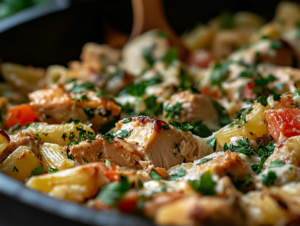Gulab Jamun holds a special place in the hearts of dessert lovers. Its origins trace back to the Indian subcontinent, and it has become a staple in many South Asian households. The name “Gulab Jamun” is derived from Persian, where “Gulab” means rose (referring to the rose-scented syrup) and “Jamun” refers to a type of deep purple-colored Indian fruit, which the dessert resembles. Traditionally, these delectable treats are made by combining khoya with a small amount of flour, shaping the mixture into balls, deep-frying them until golden brown, and then soaking them in a warm sugar syrup. The result is a dessert that’s rich, aromatic, and utterly irresistible.
Ingredients
For the Gulab Jamun:
- 1 cup milk powder
- 3 tablespoons all-purpose flour
- 2 tablespoons ghee (clarified butter), melted
- 1/2 teaspoon baking powder
- Approximately 1/4 cup warm milk (adjust as needed)
For the Sugar Syrup:
- 1 1/2 cups granulated sugar
- 2 cups water
- 4-5 green cardamom pods, lightly crushed
- 1 teaspoon rose water
- A few strands of saffron (optional)
Directions
- Prepare the Sugar Syrup:
- In a large saucepan, combine the sugar and water.
- Add the crushed cardamom pods and saffron strands.
- Bring the mixture to a boil over medium heat, stirring until the sugar dissolves.
- Once it reaches a boil, reduce the heat and let it simmer for about 5 minutes.
- Add the rose water, stir, and set aside. Keep the syrup warm.
- Prepare the Dough:
- In a mixing bowl, combine the milk powder, all-purpose flour, and baking powder.
- Add the melted ghee and mix until the mixture resembles coarse crumbs.
- Gradually add warm milk, a little at a time, mixing gently to form a soft dough. The dough should be smooth and slightly sticky but manageable.
- Cover the dough with a damp cloth and let it rest for about 10-15 minutes.
- Shape the Dough Balls:
- After resting, divide the dough into small equal portions (about the size of a marble).
- Gently roll each portion between your palms to form smooth, crack-free balls. If cracks appear, add a tiny bit more milk to the dough and knead gently.
- Fry the Dough Balls:
- Heat oil or ghee in a deep frying pan over low to medium heat. The oil should be warm but not too hot; a temperature of around 325°F (160°C) is ideal.
- Carefully add a few dough balls at a time into the oil. They will sink initially and then slowly rise to the surface.
- Fry the balls gently, stirring occasionally to ensure even browning. This process should take about 7-8 minutes per batch.
- Once they turn a golden brown color, remove them with a slotted spoon and drain on paper towels.
- Soak in Sugar Syrup:
- While the fried balls are still warm, immerse them in the warm sugar syrup.
- Ensure that the gulab jamuns are fully submerged.
- Let them soak for at least 2 hours to absorb the syrup and become soft and juicy.
Nutritional Information
Per serving (1 gulab jamun):
- Calories: Approximately 150 kcal
- Carbohydrates: 25g
- Protein: 2g
- Fat: 5g
- Saturated Fat: 3g
- Cholesterol: 15mg
- Sodium: 50mg
- Sugar: 20g
Note: Nutritional values are approximate and can vary based on specific ingredients used.
Tips for Perfect Gulab Jamun
Achieving the perfect texture for gulab jamun starts with the dough consistency. The dough should be soft and smooth, but not over-kneaded, as excessive kneading can make the gulab jamuns dense and tough. If the dough feels dry, a little more milk can be added to soften it. Conversely, if it’s too sticky, a small sprinkle of flour will help bring it to the right consistency. Another crucial factor is the frying temperature. If the oil is too hot, the gulab jamuns will turn golden brown quickly on the outside but remain uncooked inside. On the other hand, if the oil is too cool, they will absorb too much oil, making them greasy and heavy. Maintaining a consistent medium-low heat is key to ensuring even cooking. Finally, the soaking time is essential for getting that soft, melt-in-the-mouth texture. The fried balls should be immersed in warm sugar syrup for at least two hours, allowing them to absorb the sweetness and become juicy. Rushing this process can result in dry and under-flavored gulab jamuns.
Variations
For a delightful twist, try making stuffed gulab jamun by adding a filling of chopped nuts such as pistachios or almonds. For an even more indulgent variation, place a small piece of white chocolate inside before rolling the dough into balls. If you’re looking for a healthier alternative, baked gulab jamun is a great option. Instead of deep-frying, bake them in a preheated oven at 350°F (175°C) until they turn golden brown. However, be aware that the texture may differ slightly from the traditional deep-fried version. For those who prefer a less syrupy dessert, dry gulab jamun is an excellent choice. Instead of letting them soak for a long time, allow the fried balls to absorb just a little syrup before rolling them in desiccated coconut or powdered sugar for a different yet delicious take on this classic sweet.
Serving Suggestions
Gulab jamun is best enjoyed either warm or chilled, depending on personal preference. Some love the soft, syrupy texture of warm gulab jamun straight from the syrup, while others find the flavors even more delightful when served cold. For an irresistible dessert, pair gulab jamun with ice cream—a scoop of vanilla or saffron ice cream enhances the richness of the dish, creating a divine combination of flavors. Another creative way to serve this dessert is as a topping—crumbled gulab jamun can be added to rabri (thickened milk) or kheer (rice pudding) for an even more indulgent treat. To make it extra special for festive occasions, serve gulab jamun on a festive platter garnished with slivered almonds, pistachios, or edible silver foil (varak). The added elegance makes it a perfect centerpiece for celebrations like Diwali, Eid, or weddings.
Frequently Asked Questions (FAQs)
1. Why did my gulab jamuns turn hard?
This usually happens when the dough is over-kneaded or too dry. To fix this, ensure you add enough moisture while preparing the dough and avoid excessive handling.
2. Why did my gulab jamuns break while frying?
Too much moisture in the dough can cause the gulab jamuns to disintegrate in the oil. Make sure the dough is soft but firm enough to hold its shape.
3. Can I make gulab jamun in advance?
Yes! Gulab jamuns can be prepared a day or two in advance. Store them in the syrup in an airtight container in the refrigerator. Reheat them slightly before serving.
4. How long can I store gulab jamun?
They can be stored in the refrigerator for up to 5-7 days. If frozen, they last up to a month. Always warm them slightly before serving to restore their soft texture.
5. Can I use whole wheat flour instead of all-purpose flour?
While all-purpose flour gives a softer texture, you can use whole wheat flour for a slightly denser but healthier version.
Conclusion
Gulab Jamun is not just a dessert; it’s an emotion! Whether you’re making it for a festival, a wedding, or simply to satisfy a sweet craving, this indulgent treat never disappoints. With this step-by-step guide, you can make perfect gulab jamuns at home that rival the ones from your favorite sweet shop.
So, roll up your sleeves, gather your ingredients, and get ready to make this iconic Indian dessert. Happy cooking!
Print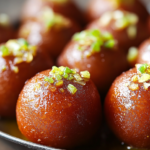
Gulab Jamun Recipe – Soft, Juicy & Perfect Indian Dessert
5 Stars 4 Stars 3 Stars 2 Stars 1 Star
No reviews
- Author: Ferial Hammachi
Ingredients
For the Gulab Jamun:
- 1 cup milk powder
- 3 tablespoons all-purpose flour
- 2 tablespoons ghee (clarified butter), melted
- 1/2 teaspoon baking powder
- Approximately 1/4 cup warm milk (adjust as needed)
For the Sugar Syrup:
- 1 1/2 cups granulated sugar
- 2 cups water
- 4–5 green cardamom pods, lightly crushed
- 1 teaspoon rose water
- A few strands of saffron (optional)
Instructions
- Prepare the Sugar Syrup:
-
- In a large saucepan, combine the sugar and water.
- Add the crushed cardamom pods and saffron strands.
- Bring the mixture to a boil over medium heat, stirring until the sugar dissolves.
- Once it reaches a boil, reduce the heat and let it simmer for about 5 minutes.
- Add the rose water, stir, and set aside. Keep the syrup warm.
- Prepare the Dough:
- In a mixing bowl, combine the milk powder, all-purpose flour, and baking powder.
- Add the melted ghee and mix until the mixture resembles coarse crumbs.
- Gradually add warm milk, a little at a time, mixing gently to form a soft dough. The dough should be smooth and slightly sticky but manageable.
- Cover the dough with a damp cloth and let it rest for about 10-15 minutes.
- Shape the Dough Balls:
- After resting, divide the dough into small equal portions (about the size of a marble).
- Gently roll each portion between your palms to form smooth, crack-free balls. If cracks appear, add a tiny bit more milk to the dough and knead gently.
- Fry the Dough Balls:
- Heat oil or ghee in a deep frying pan over low to medium heat. The oil should be warm but not too hot; a temperature of around 325°F (160°C) is ideal.
- Carefully add a few dough balls at a time into the oil. They will sink initially and then slowly rise to the surface.
- Fry the balls gently, stirring occasionally to ensure even browning. This process should take about 7-8 minutes per batch.
- Once they turn a golden brown color, remove them with a slotted spoon and drain on paper towels.
- Soak in Sugar Syrup:
- While the fried balls are still warm, immerse them in the warm sugar syrup.
- Ensure that the gulab jamuns are fully submerged.
- Let them soak for at least 2 hours to absorb the syrup and become soft and juicy.

